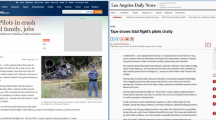Abstract
One of the most important tasks in data cleansing is to detect and remove duplicate records, which consists of two main components, detection and comparison. A detection method decides which records will be compared, and a comparison method determines whether two records compared are duplicate. Comparisons take a great deal of data cleansing time. We discover that if certain properties are satisfied by a comparison method then many unnecessary expensive comparisons can be avoided. In this paper, we first propose a new comparison method, LCSS, based on the longest common subsequence, and show that it possesses the desired properties. We then propose two new detection methods, SNM-IN and SNM-INOUT, which are variances of the popular detection method SNM. The performance study on real and synthetic databases shows that the integration of SNM-IN (SNM-INOUT) and LCSS saves about 39% (56%) of comparisons.
Access this chapter
Tax calculation will be finalised at checkout
Purchases are for personal use only
Preview
Unable to display preview. Download preview PDF.
Similar content being viewed by others
References
H. Galhardas, D. Florescu, D. Shasha, E. Simon, and C. A. Saita. Declarative data cleaning: Language, mode, and algorithms. In Proc. 27th Int’l. Conf. on Very Large Databases, pages 371–380, Roma, Italy, 2001.
M. Hernandez. A generalization of band joins and the merge/purge problem. Technical Report CUCS-005-1995, Columbia University, February 1996.
M. Hernandez and S. Stolfo. The merge/purge problem for large databases. In Proceedings of the ACM SIGMOD International Conference on Management of Data, pages 127–138, May 1995.
K. S. Larsen. Length of maximal common subsequences. Available from http://www.daimi.au.dk/PB/426/PB-426.pdf.
M. L. Lee, T. W. Ling, and W. L. Low. Intelliclean: A knowledge-based intelligent data cleaner. In Proceedings of the sixth ACM SIGKDD international conference on Knowledge discovery and data mining, pages 290–294, 2000.
M. L. Lee, H. J. Lu, T. W. Ling, and Y. T. Ko. Cleansing data for mining and warehousing. In Proceedings of the 10th International Conference on Database and Expert Systems Applications (DEXA), pages 751–760, 1999.
Infoshare Limited. Best value guide to data standardizing. InfoDB, July 1998. Available from http://www.infoshare.ltd.uk.
A. E. Monge. Matching algorithm within a duplicate detection system. In IEEE Data Engineering Bulletin, volume 23(4), December 2000.
A. E. Monge and C. P. Elkan. An efficient domain-independent algorithm for detecting approximately duplicate database records. In Proceeding of the ACMSIGMOD Workshop on Research Issues on Knowledge Discovery and Data Mining, Tucson, AZ, 1997.
V. Raman and J. M. Hellerstein. Potter’s wheel: An interactive data cleaning system. In Proc. 27th Int’l. Conf. on Very Large Databases, Rome, 2001.
A. Silberschatz, M. StoneBraker, and J. Ullman. Database research: Achievements and opportunities into the 21st century. In SIGMOD Record (ACM Special Interest Group on Management of Data), page 25(1):52, 1996.
Author information
Authors and Affiliations
Editor information
Editors and Affiliations
Rights and permissions
Copyright information
© 2002 Springer-Verlag Berlin Heidelberg
About this paper
Cite this paper
Zhao, L., Yuan, S.S., Peng, S., Wang, L.T. (2002). A New Efficient Data Cleansing Method. In: Hameurlain, A., Cicchetti, R., Traunmüller, R. (eds) Database and Expert Systems Applications. DEXA 2002. Lecture Notes in Computer Science, vol 2453. Springer, Berlin, Heidelberg. https://doi.org/10.1007/3-540-46146-9_48
Download citation
DOI: https://doi.org/10.1007/3-540-46146-9_48
Published:
Publisher Name: Springer, Berlin, Heidelberg
Print ISBN: 978-3-540-44126-7
Online ISBN: 978-3-540-46146-3
eBook Packages: Springer Book Archive




